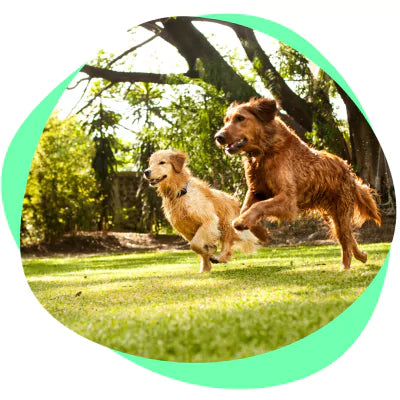If your dog is always alert, restless, reacts to every noise, and has difficulty calming down, you most likely would call this dog hyperactive. But is it a fair assessment of the dog’s behaviour? According to Clinical Behavioural Medicine for Small Animals (Karen Overall, 1997) true hyperactivity in canines is rare. Hyperactivity (referred by scientists as hyperkinesis in dogs) is characterized by several factors, either isolated instances or a combination of :
- Increased heart rate
- Poor body condition scores
- Reactivity and agitation
Hyperactive dogs are easily aroused by external stimuli and remain at a high level of arousal even after removal of the stimuli. Restlessness, constant non-stop movement and panting, frantic abnormal behavior (e.g. the dog chasing his own tail) and unfocused eyes are other very common superficial symptoms of dog hyperactivity. If you suspect that your dog might be hyperactive, please consult your veterinarian.

As mentioned, hyperactivity is rare in dogs. High drive, breed characteristics, conditioned behavior, and lack of appropriate physical and mental stimulation are all factors that may be mistaken for hyperactivity.
There is a fundamental difference between abnormal and standard yet undesirable behaviors in dogs.
Let us look at the breeds whose parents often think, "Why is my dog so hyper?" And let us take a look at why those breeds were bred.
- Jack Russel Terrier and Fox Terrier. These small dogs have boundless energy. Bred as fox hunting dogs, they are stubborn, hardy and active (how else will one fight a fox inside the foxhole for several hours?)
- Border Collie, Australian Shepherd and Australian Kelpie. These dogs were bred as intelligent and high energy. They could herd sheep and cows through fields and mountains for hours!
- Siberian Husky. Originally bred in Siberia (Russia), these dogs tirelessly pull the sled through snow for miles.
- Golden Retriever, Labrador Retriever – bred with an impeccable sense of smell and tracking, they would accompany hunters and track down wounded game, retrieving it for their owners.
- German Shepherds were bred from Germany’s most intelligent and obedient dogs. They herded sheep and would protect them from oncoming predators.
So, once again: what do these dogs have in common? These dogs are bred to be highly aroused both physically and mentally. They are meant to be active, attentive, and well-exercised. Without proper training or a positive outlet for their energy, the dogs will seek one out often with negative results.

EXERCISE AND TRAINING
Imagine this scenario: an owner brings a Siberian Husky to the vet because they’re uncontrollable. The veterinarian may ask the owner how much physical activity the Husky receives a day.
“Plenty!” the dog owner might insist, “I walk him around the block every day!”
Again, it is important to know your dog’s breed. Siberian Huskies, when trained properly, can run up to 125 miles per day. You read that correctly. If you plan on owning a Husky, do not be surprised if they have a bit more energy than you do.
Thus, the importance of physical and mental stimulation.
- Exercise – If you have a hyperactive dog, perhaps the most important thing for you to do is to give them plenty of physical exercise. Wearing them out physically gives them a chance to get rid of their anxiety and energy. It improves dog’s training sessions, their sleep schedule, and makes their digestive system healthier. Consistent, physical activity is an absolute must. And the lack thereof can lead to symptoms of hyperactivity.
- Training – After a rousing game of fetch, your dog would love to chow down. What a great time to keep them focused on the treat in your hand. Aha! Training sessions after exercise are a great way to keep your dog mentally stimulated. Despite the fact that “being untrainable” is one of the major symptoms of hyperactivity, your dog simply might have been in an unsuitable learning environment.

WHEN CALMING SUPPLEMENTS CAN HELP HYPERACTIVE DOGS
I have been training different breeds of dogs for more than 20 years and doing all kinds of sports with working dogs. You can assume that I provide plenty of exercise for my dogs and tons of mental stimulation. But for some dogs, that simply is not enough. I have a 5-year-old smooth fox terrier, Ace.
When we come home from a 5 mile walk, he still has difficulty settling down. He knows all the possible tricks and loves to learn new ones. He is constantly following me around the house, waiting for something interesting to happen.
Obviously, he needs even more exercise, but I have other things in life besides my beloved fox terrier. And let’s face it most of us are not hunters or shepherds. We have busy lives and while we try to be very active and spend sufficient amount of time exercising our dogs, for some it is still not enough.
You probably can go to your veterinarian and get a prescription to a calming medicine for dogs to help yours settle down. But I didn’t want to medicate my healthy dog. I just wanted him to be able to calm himself down. That is why I started researching natural remedies. Since ancient times people were using different herbs, flowers, and roots to achieve a calming and relaxing effect. That was the path I decided to follow to help my dog calm down.
I use supplements with only natural and bioavailable ingredients. These ingredients are mixed at the optimal levels to ensure they are absorbed completely into your dog’s body with minimal waste – so you can be sure your furry friend will benefit from the full effects of this supplement.
Chamomile Flower
This is one of the safest and most versatile herbal pet remedies. It is commonly used to treat both stress and anxiety in dogs with mild sedative effects. Chamomile can also be used to help if your dog is struggling to sleep.

Passionflower
This is an herbal supplement which has been used historically to treat anxiety, insomnia, and seizures. It helps your dog maintain a healthy relaxation with an overall calming effect.

Valerian Root
This is a popular sedative and anti-anxiety herb for both humans and pets. This is recommended if your dog is experiencing noise phobias, such as from thunderstorms, fireworks, and gunfire. It is a natural way to provide stress relief for dogs.
Ginger Root
This ingredient is great for treating your dog’s nausea and upset stomach, especially during travel. Ginger root is also extremely high in antioxidants, which makes it great in the fight against heart disease.
Another great ingredient in calming formulas which is worth mentioning separately is L-Tryptophan. L-Tryptophan is a natural amino acid found in many proteins, which is involved in the production of the hormone serotonin. It promotes calm behaviour and increases emotional well-being in dogs. And since L-Tryptophan is a natural amino acid, it can improve your dog’s behavior without the risk of organ damage.

So, I started giving an all-natural calming supplement to my fox terrier on a regular basis 6 months ago with incredible results! We are still enjoying long walks but at home Ace is such a nice and relaxed boy. He also started sleeping much better.

